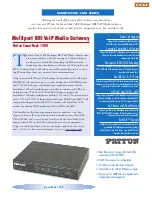
© 2015 Active Research Limited
Page 4
Introduction
The USG-2’s OPTO-isolated input and ISO-Drive isolated output makes it safe to connect NMEA 0183, RS232 and
RS422 devices to your PC without the danger of ground loops. The high quality, shielded USB lead included with the
USG-2 provides a high level of water protection when mated with the high retention USB receptacle, all vital features
in the high vibration, noisy marine environment. The 2-part screwless connector makes connecting devices quick and a
DIN rail mount option is available to reliably secure the USG-2 to a bulkhead.
Solving ground loops
The first problem encountered when using a standard USB to serial converter (or a standard RS232 port) is that the
ground of the computer is then connected directly to the NMEA 0183 system ground.
Computers are often powered from a mains inverter, generator set or directly from the mains supply when in dock,
whereas the marine electronics are normally connected to the ships battery set.
This means that when you connect the two systems together, you are joining two different power systems. This can
sometimes result in no visible issues, but more often it results in one of three consequences:
1.
Data corruption - the data becomes garbled as the electrical voltage signals now float on the noisy ground signals
flowing between the two power systems.
2.
The computer crashes intermittently as ground currents flow into its sensitive electronic circuitry. This can cause
permanent damage to the computer’s motherboard.
3.
In the case of large ground loop / ground potential difference faults, some components can melt / catch fire / blow
fuses or cause earth leakage devices to trip.
The USG-2 solves all these problems by providing a safe, opto-isolated 1500 Volt barrier between the two systems.
Because the data signals travel across this isolating barrier as light, the signals do not share the same ground, safety is
assured and no current can flow between the two power systems. In addition, a built-in power isolator completes this
comprehensive suite of protection.
Overcoming issues with different standards
Computer serial or “COM” ports use the RS232 standard. This uses a ground and a receive pin to get data from a
connected system. Data is sent as voltages referenced to ground on a single transmit line. This type of drive is known
as “Single-ended”.
In contrast, NMEA 0183 (RS422) devices use a “Differential” system, where a “Positive” data line (A/+) and a
“Negative” data line (B/-) move in opposition to each other.
It is important to note that an NMEA 0183 device with a (standard) non-isolated differential output should never have
its negative data line (B/-) connected to the computer’s ground as part of a data connection. This will at the very least
fail to work and at the worst, damage the NMEA 0183 device, computer or both. In contrast, the fully isolated Actisense
USG-2 can safely have its negative data line (B/-) connected to ground (if required) without issue.
The USG-2 solves all these problems by using ingenious circuitry unique to Actisense in both its “Listener” (receiver)
circuit and its ISO-Drive™ “Talker” (transmitter) circuits. These circuits are compatible with both RS232 and NMEA 0183
(RS422) devices and signals. Please refer to the NMEA 0183 Interfacing section for more information on “Talkers”
and “Listeners”.
Simple connection to a computer with no serial port
Laptop and desktop computers no longer come equipped with RS232 type serial ports any more, however the need
to connect serial devices to them has not disappeared. The USG-2 creates a fully isolated marine standard NMEA 0183
port from any computer USB port.
This port appears on the computer system as a Virtual COM port, and so can be used with all standard marine
navigation and display software available today.






























